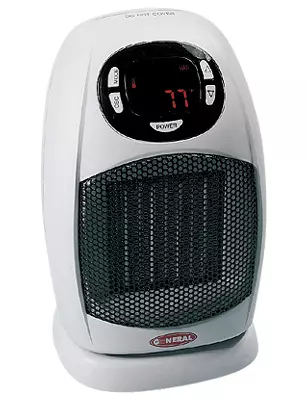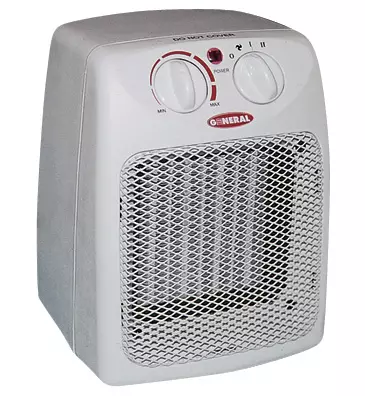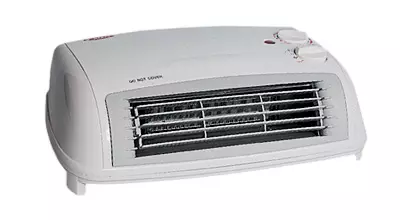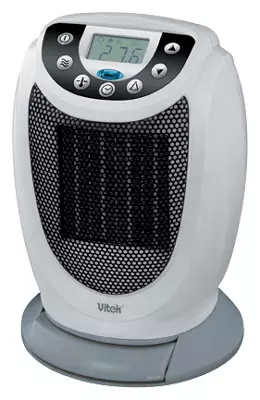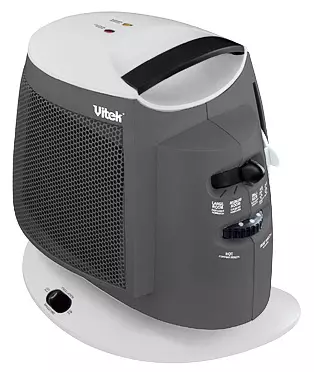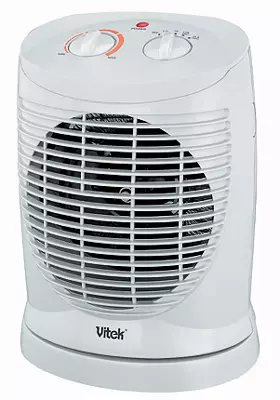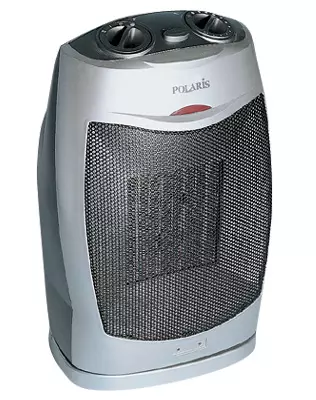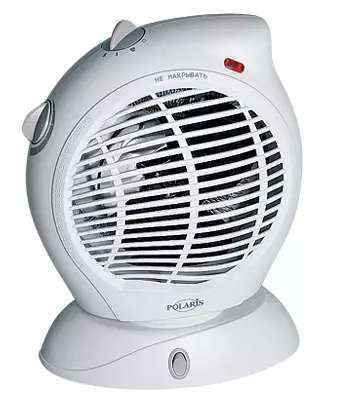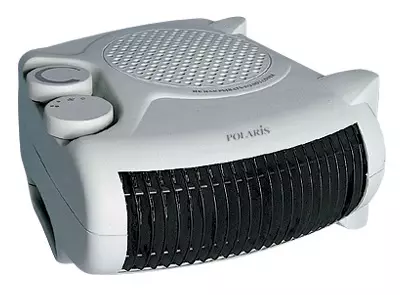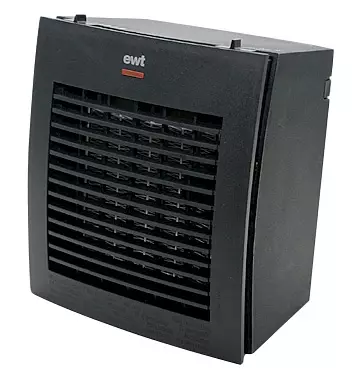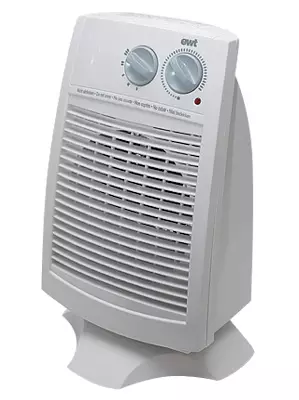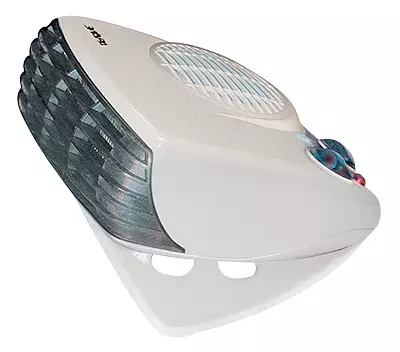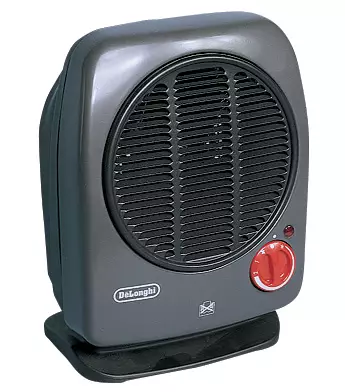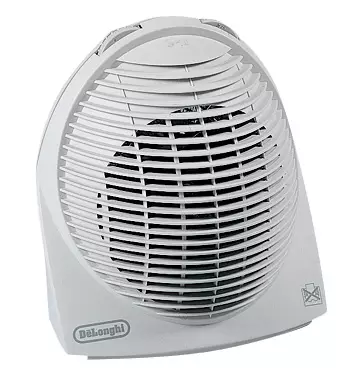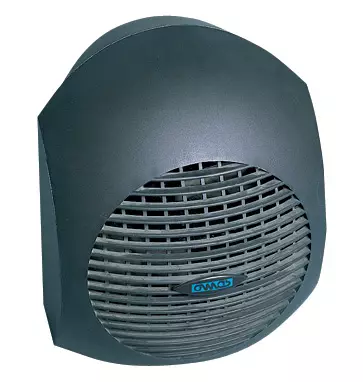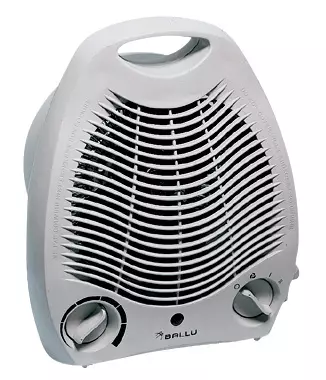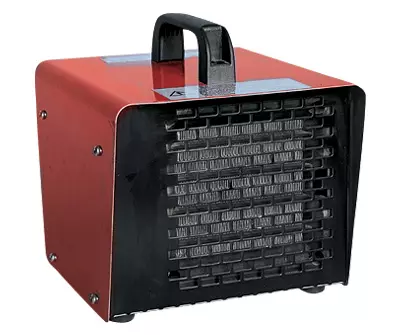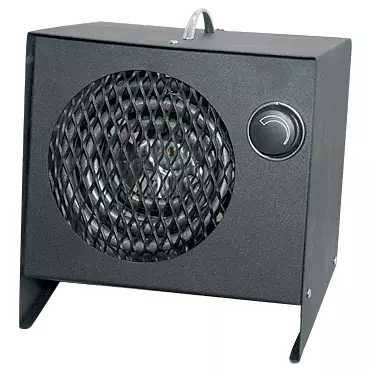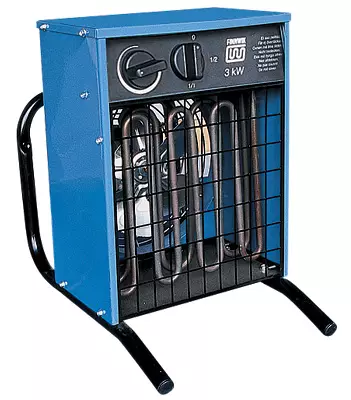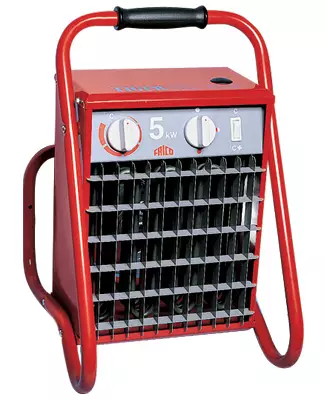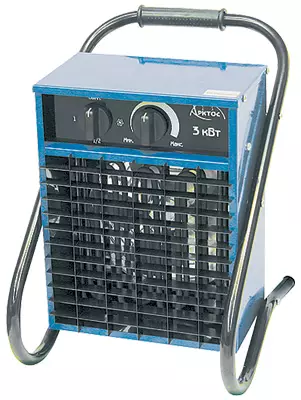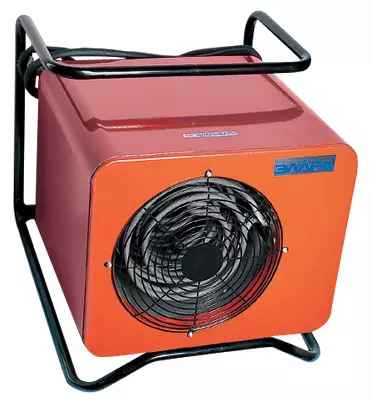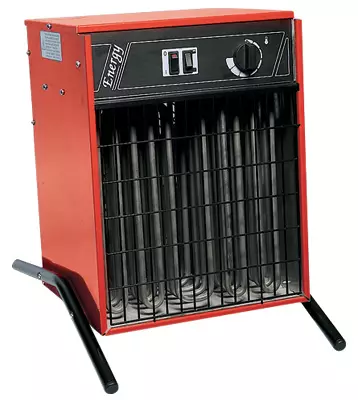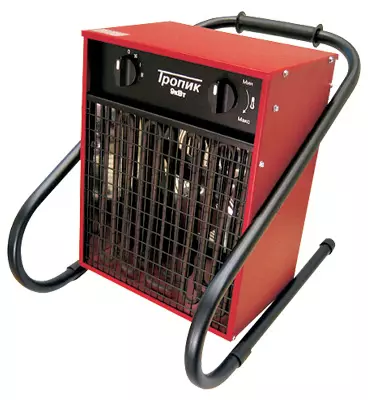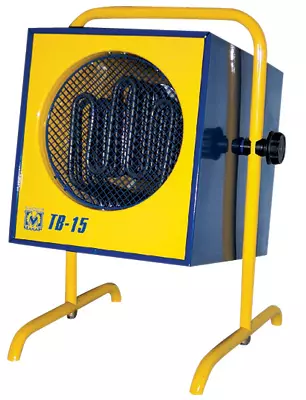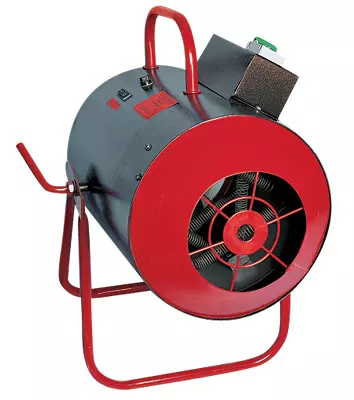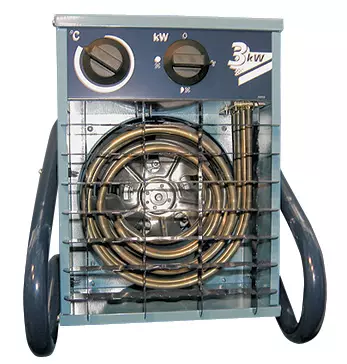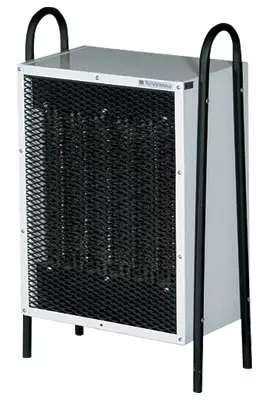Electric fan heaters: types, structural features, advantages and disadvantages of devices. Comparative characteristics of some models.
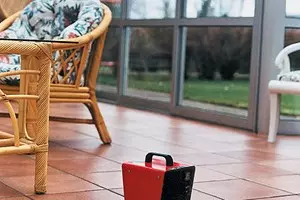
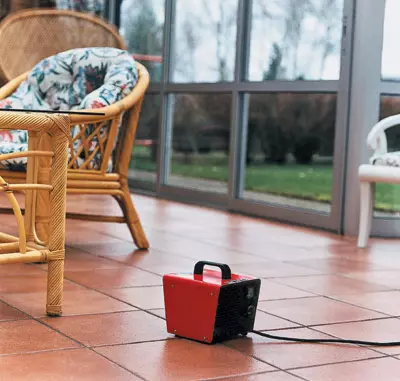
Household tabletop ceramic fan heater KX2 from Veab (Sweden) on a glazed veranda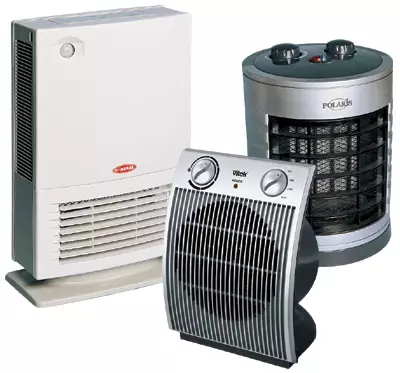
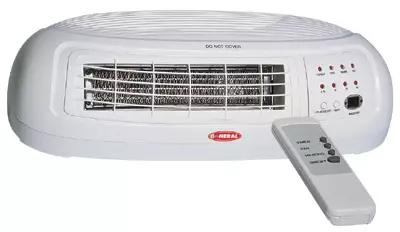
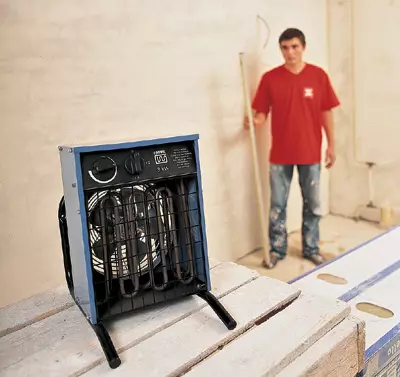
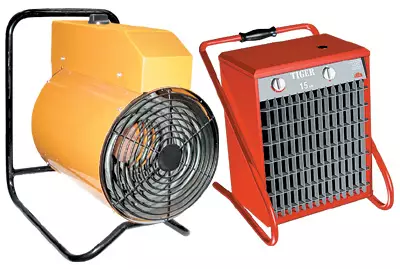
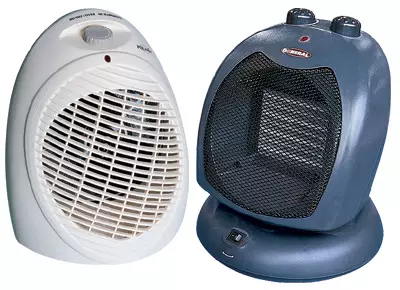
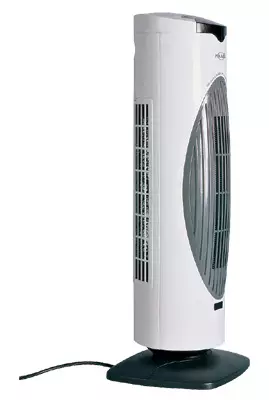
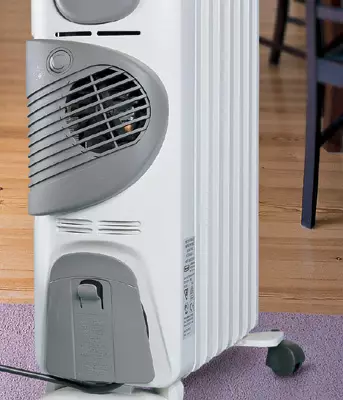
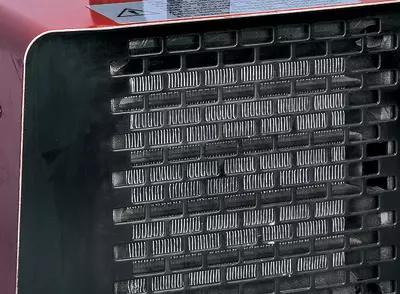
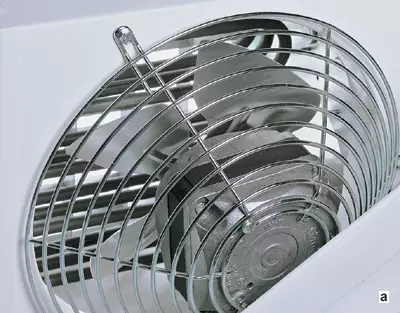
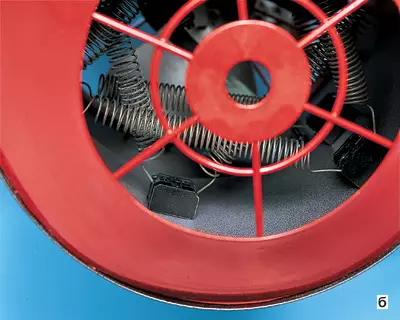
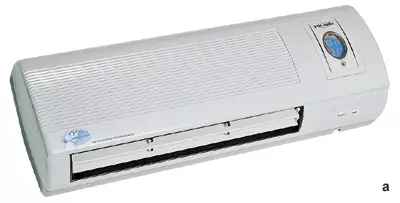
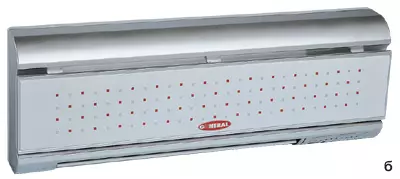
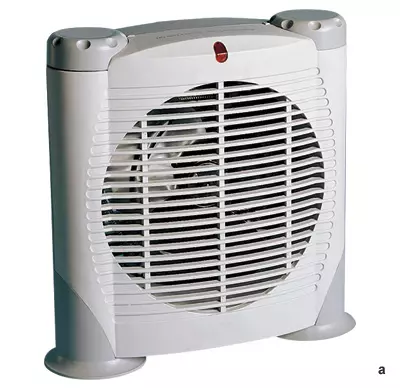

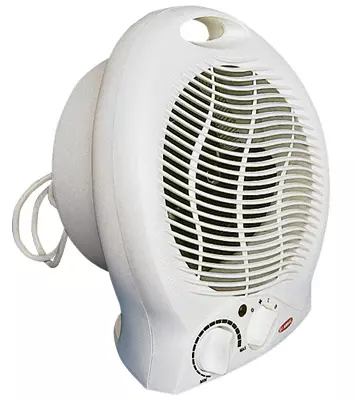
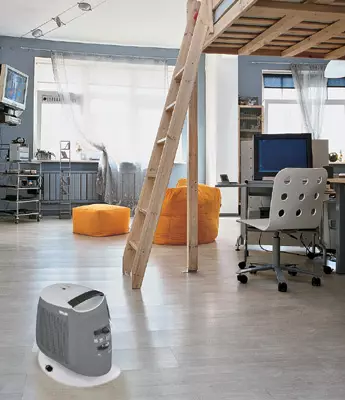
Photo V.Nepledov
Desktop fan heaters can be installed on the floor, mainly comply with the safety requirements.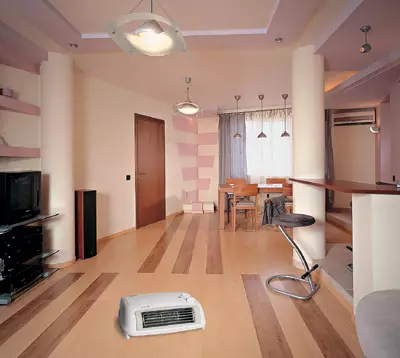
Photo by D.Minkina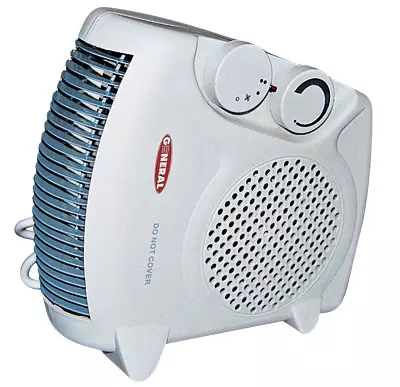
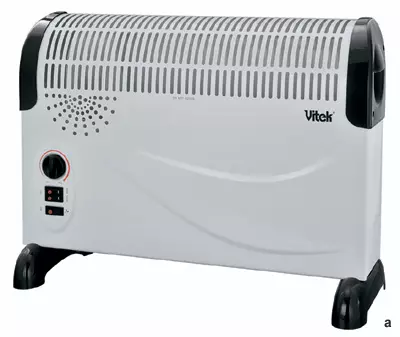
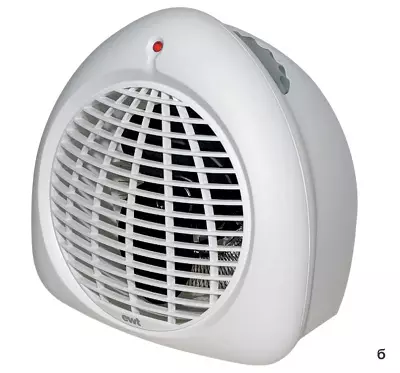
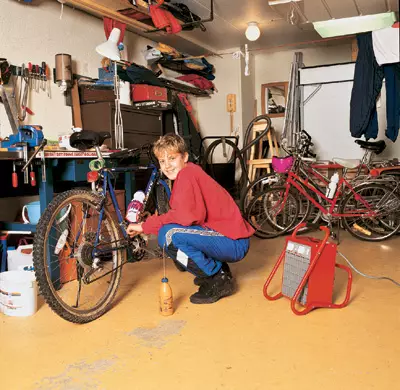
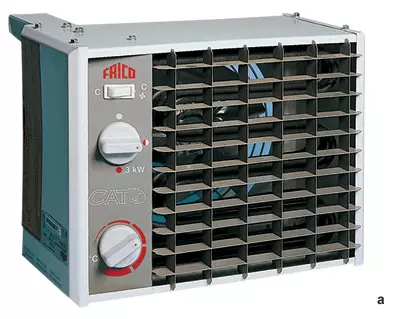
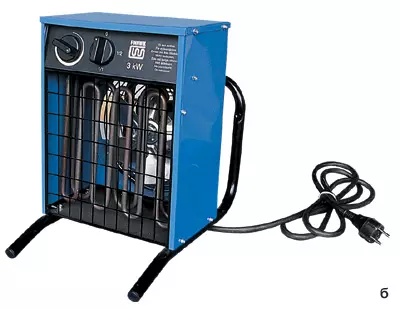
An excellent New Year's gift capable of literally and in the figurative sense to bring heat into the house is an electric fan heater. This compact and highly efficient device will easily fill the lack of heat not only in winter, when frost cracks on the street, and the heating does not cope with its duties, but also in the spring, autumn and even in the summer, at the time when the batteries are turned off, and insidious cold have come back.
To whom smaller, who is more!
In stores selling electronic equipment and climate equipment, there are tens of models of electrical fan heaters. The most widely represented household devices with a capacity of 1.5-2.5 kW, used for additional heating of the rooms, as well as semi-industrial devices with a capacity of 2 to 40 kW (they are also called thermal guns). The latter are indispensable at a construction site, where they serve for drying wet rooms, but also apply for additional (to help batteries) heating or main heating of utility rooms, such as garages, private workshops, storage rooms, greenhouses or cold veranda. There are still electrical thermal vehicles on the market, designed to cut out outdoor air flows penetrating through door and window openings, but in everyday life they are extremely rare.
Like most electrical thermal devices, all fans of this kind have a very simple design. The housing (rectangular, cylindrical or other form, the variants of the options) is the electric motor with an impeller, when the cold air is rotated from the room (or from the street) inside the housing, and then purged through a special heating element. The result is the result of heat transfer from the heated body by blowing its flow the air temperature rises, after which it is already hot, leaves the fan heater. To negligently, the user did not shove his fingers inside the working device, the inlet and outlet of the device are closed with a decorative grid (sometimes grid). Elements of the system of automation and protection can either embed directly into the body of the fan heater (portable models), or placed in a separate remote unit (some types of stationary heaters).
The efficiency of electrical heaters of the fan type reaches 95-99%. This means that almost all the electricity supplied to them, they turn into a heat that enters the heated room. The air temperature difference at the inlet and outlet can be 25-40 degrees, but some models have a stream can be heated to 100 and even 150c. Buying such devices is probably not worth it, especially if you need a heater for residential premises, since the air flow with a temperature of more than 55s can easily burn hands. In general, choose a fan heater is best with the help of specialists; But if you still buy it yourself, one rule should be remembered: every 10m2 rooms in a typical urban apartment (with 2,75m ceilings) should have 1 kW of a household fan heater.
Heat shield
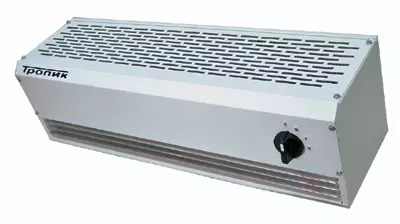
Dignity
Speaking about the advantages of modern fan heaters and thermal guns (about which they will be discussed in our article) before the similar equipment of other types, it is important to note, first of all, The lowest cost of buying these devices shown in the kilowatt of the power of the device. For household models, 1 kW of power costs the buyer at $ 7-10, for guns, respectively, from $ 15-20 (when buying an aluminum radiator for water heating system, this kilowatt is much more expensive, about $ 50-70).
Another advantage is all Fan heaters are compact . For example, compared with an electroconvector on 2 kW, a domestic fan heater of similar power takes approximately 5 times less than a smaller volume. Anagen the room they can make much faster than other types of heating devices. So, for only 20-40 minutes after connecting to the network, the heating system based on stationary heat guns can lift the temperature in the brick garage from 5 to 22c. In a word, came, turned on the heating and went with the spatula to the fresh air to scatter the snow before the gate. Returning to a well-warmed, truly warm garage!
With the reserve of sufficient electrical power No significant costs and installation of equipment . To connect portable models, everything you need is to bring the device and stick the plug into an electrical outlet.
Scheme of a household fan heater
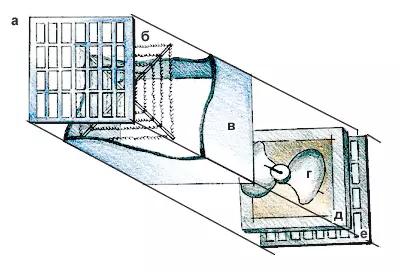
B - heating element;
enclosure;
g-electric fan;
DR filter;
E- protective filter grille
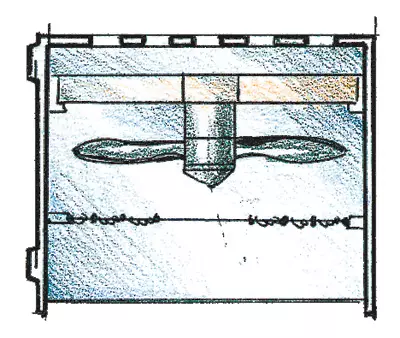
disadvantages
It should be noted Significant power consumption This kind of instruments. Because of this, they are not always possible to connect to an existing wiring. Inhouses located in the central part of the city and electrified in Soviet times, because of them can knock through the traffic jams. Moreover, additional heated rooms with the help of one or two household electrical fan heaters can lead to a significant (sometimes time to two- and more stable) increase in the amount of utility payments. For example, for one hour of the continuous operation of a two-chip fan heater in the maximum power mode for electricity will have to additionally pay 2 rubles 44 kopecks. It may have a lot of hours for the winter. Aesley, especially since talking about a whole system of heating on the basis of fan heaters, then this thing, gently expressing, is very expensive in operation.Uneven temperature in the height of the room Heated by fan heaters, creates a sense of discomfort. Naturally, hot air tends to climb up, and with each extensive height meter, the temperature rises by about 2.5 s. Thus, if at the floor level even comfortable- 22s, then at an altitude of 4m is already quite hot-32c, and there is already "all higher and higher, and above!" In accordance with the laws of physics, overheating the upper zone of the structure leads to a sharp increase in heat loss through the roof and, therefore, to an increase in costs ... on heating the street. So, if a private gym is heated or a high ceilings workshop, utility payments can grow simply astronomically. In order not to throw money in the literal sense to the wind, in high rooms together with conventional models, the ceiling fans were invented, providing temperature alignment in height. Such a solution allows to reduce heating costs by 30% or more.
The noise level of the working fan heater is high enough . Even in the most modern household models, it is about 35-45DB (a), so it may be difficult to work as a focus on such "music". The same, if the room is not particularly often wet cleaning, warm air flow can raise dust - From the floor, furniture IT.P.
Besides, Heating with the help of fan heaters is not always environmental . Of course, contrary to the fact that some sellers are stated, no oxygen fan heaters do not burn (in thousands, if not in mills times more than 2 o2 consumes a normal gas stove in the house). However, unpleasant odors (plastic, calene iron), especially when the new device is first turned on, as well as due to the combustion of organic dust, it may appear in the room completely. In addition, the flow of heated air has a very low relative humidity. Because of this, the person dries the skin and mucous membranes, there is a hole in the throat and rubbed in the eyes.
In search of eco-friendly heat
The most disadvantaged from the point of view of ecology and household fan heaters and guns, in which the electric heating element is made of a pigtail spiral nichrome wire. Heated to very high temperature (over 700 ° C, and this is the temperature of the glow) of the wire heater significantly reduces the relative humidity of the heated air, and a specific smell appears on the hot spiral of the spiral in the room.
Heat guns and household fan heaters with tubular electric heater type TEN, which is a bent ring or letter "M" steel tube with pressed inside with a heating conductor and backfilling from quartz sand, also reduce the relative humidity of the air flow, however, it is almost slightly, and dust on them almost Does not burn. After all, the area of the working surface of the Tanov, in contact with the air flow, is greater than that of wire heaters, and its temperature is much lower than that of the helix, about 300c.
The most ecologically recognized metal-ceramic heaters used in more expensive household models (they are also called ceramic; sellers recommend buying them for heating apartments). Such an element consists of a plurality of small cells, through which, as through honeycombs, the air flow is blown. The area of the working surface is large here, and the temperature is 120-200c. When operating the best models of ceramic fans worsening air quality indoors not to feel.
Power of burning gas
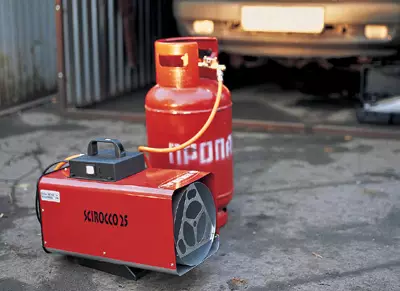
Mal, yes delete!
Household electrical fan heaters consume about 1.5-2.5 kW of electricity in the maximum power mode. They are used only for short-term (up to 24 hours in a row) of additional heating of the rooms or for blowing up the warm air of any part of the room (for example, rocking chairs on a glazed loggia). Although all these devices are unpretentious in service, in order to avoid a fire, it is important to ensure that bedding, furniture, clothing, curtains are located from them at a distance of at least 1M (at the same time the devices themselves can not be covered in any way!). Operate household fan heaters in wet premises are unacceptable (except for specific heated towel rail fan-heaters for bathrooms). In order to avoid overheating, do not forget to clean the stray filter from dust, provided for pre-cleaning of incoming air in many modern models.Long-selling household fan heaters of three types: desktop, outdoor and wall mounted.
The share of the market for desktop household fan heaters, according to some estimates, exceeds 90%, now these devices are most popular and selling. For air heating, they are equipped with wire and metal-ceramic heaters, sometimes with Tanni. The case of desktop models are made in the form of high (up to 30cm) or, on the contrary, it is flattened (not more than 10 cm) boxes, as well as a high cylinder, bizarrely deformed sphere of IT.P. If you plan to consider the fan heater as a design element, it is logical to choose a model in a plastic case (it can have the most intricate configuration), but if there is a practicality and reliability in the first place, it is better to buy a device in a steel sheet housing.
"Delication" jet of warm air in desktop fan heaters with axial impeller, as a rule, minimal (no more than 1-1,5m). Through these devices, the heated air is blocked strictly in the axial direction (it comes from behind, it comes in front). Avot in a centrifugal impeller models The air flow turns inside into 90: it is sued from the room through the upper (or lower) grille, and it comes out through the front. The fans with a centrifugal impeller are capable of creating a more powerful heat flow, but sometimes they are noticeably noisy. To change the direction of blowing a desktop fan heater, without coming once again to the device, you can purchase a model with an automatic rotary stand that allows the body to rotate in the sector up to 180 (different models are different).
Fan heaters of the second type, outdoor, so far for Russia in the wonder, however, this class of thermal equipment undoubtedly deserves the attention of buyers. Such models warm all the room, including its lower zone, they are ergonomic, often they can be perceived as interior decoration. Outdoor fan heaters externally resemble a column with a height of about 70cm and a diameter of about 15 cm, installed on an automatic rotary stand (the rotation sector - 60). Inside such devices there is a diametrical fan that combines the advantages of axial and centrifugal impellers (low noise level, greater performance), as well as a metal-ceramic heater. Another type of floor systems repeats the contours of outdoor electrical convectors, only instead of metal-ceramics inside they are installed spiral from nichrome wire and centrifugal fan.
The third type of household fan heaters is stationary. Structurally, they strongly resemble the wall internal blocks of split systems, only in a reduced form. Most often have an elongated rectangular, sometimes a cigar-shaped housing fixed on the wall. Watch devices use a diametrical fan and ceramic heaters. To improve the distribution of warm air around the room, horizontal up-down shutters are used (Swing mode).
Among the manufacturers of household fan heaters there are a lot of firms with a world name, but often the name of the producer of a particular model does not coincide with the country in which the trademark is registered. Moreover, in stores you can meet the same models of household fan heaters, but sold under different trademarks. However, there is nothing terrible in this, the reasonable buyer always acquires the heating device, and not a brand, and therefore should be guided, first of all, on the quality of equipment and the ability to repair it or replace it if necessary.
Desktop fan heaters to the Russian market are supplied under the trademarks Ballu (Taiwan), Delonghi (Italy), Elenberg (Russia), Generalland, Omas (Italy), Polaris (United Kingdom), Saturn (Czech Republic), EWT (Germany), Vitek (Austria), Veab (Sweden), Elara (Russia). Models with a spiral heater are the most democratic, they cost $ 12-30. Ceramic tabletop are more expensive - $ 20-60. Floor fans under the trademarks Polaris, Vitek and EWT are sold at a price of $ 60-65. The cost of stationary wall-mounted fan heater fluctuates ranges within $ 26-64, and in this equipment group, no doubt, is leading Polaris and GENERAL.
Automation of household fan heaters
Simple model of desktop fan heater control automatics electromechanical, the power switch is installed on the housing (sometimes with the network indicator light), as well as a stepped heater power controller and / or bimetallic thermostat. Power control allows you to select the heating rate of the room. Very often in domestic portable desktop systems, the regulator has an additional position "0". This is a cooling air supply mode when the heater is disabled, but the fan continues to work (such models can be used in summer, as an "electrical outhill"). The bimetallic thermostat does not adjust the heating rate, and sets the temperature growth limit in the heated room. It is possible to limit the heating from 0 to 35-40C, but how real temperature dropped or rose, the winner of the heat controller with mechanical control determines only in its feelings (there is no scale in degrees on the knob-knob).
Electronic control is used in expensive devices to which the most advanced desktop, outdoor and stationary ceramic fan heaters are. To enable a portable electronic control device and select the desired mode, you need to use the keypad built into the case, as well as information displayed on a digital or LED scoreboard (current and set temperature, IT.P. mode). The electronic thermostat in the electronic control system, as a rule, is characterized by high accuracy of work (deviation of not more than 0.1C). It can work out and non-freeze mode when the fan pad is automatically turned on if the temperature drops to 4-5. The electronic timer allows you to assign a moment when the device is de-energized. You can manage the most "advanced" devices, desktop and outdoor, as well as without exception with stationary household fan heaters, you can not get out of the place: they have a remote remote.
To protect a person from burns, and the material of the housing - from overheating and deformation is used thermal contact, opening the power circuit by increasing the temperature of the body elements of the fan heater to the critical value (55-60C). The most perfect portable desktop and outdoor models have a trip function when tipping over. All devices have one or another protection against electric shock. Protection against voltage drop in the network, as well as the function of safe shutdown in wall ceramic fan heaters is useful.
| KRP-7. Manufacturer: GENERAL. Heater: Metal Ceramics Heating Power: 800 / 1500W Control: electronic Cost: $ 58 |
| KRP-4. Manufacturer: GENERAL. Heater: Metal Ceramics Heating capacity: 1000 / 1500W Control: Electromechanical Cost: $ 32 |
| NW-15. Manufacturer: GENERAL. Heater: Metal Ceramics Heating Power: 800 / 1500W Control: Electromechanical Cost: $ 59 |
| VT-1741. Manufacturer: Vitek. Heater: Metal Ceramics Heating capacity: 800/1200 / 1500W Control: electronic Cost: $ 37 |
| VT-1735. Manufacturer: Vitek. Heater: Metal Ceramics Heating Power: 600 / 1650W Control: Electromechanical Cost: $ 33 |
| VT-1737. Manufacturer: Vitek. Heater: Metal Ceramics Heating Power: 600 / 1650W Control: Electromechanical Cost: $ 22 |
| PCDH 0118. Manufacturer: Polaris. Heater: Metal Ceramics Heating capacity: 1800W Control: Electromechanical Cost: $ 30 |
| PCDH 0620. Manufacturer: Polaris. Heater: spiral Heating capacity: 2000W Control: Electromechanical Cost: $ 25 |
| PFHH 20A. Manufacturer: Polaris. Heater: spiral Heating capacity: 1000 / 2000W Control: Electromechanical Cost: $ 20 |
| C55 Manufacturer: EWT. Heater: Metal Ceramics Heating capacity: 750/1500W Control: Electromechanical Cost: $ 60 |
| Clima 574 TLS. Manufacturer: EWT. Heater: spiral Heating capacity: 800/1200 / 2000W Control: Electromechanical Cost: $ 60 |
| TV-2. Manufacturer: "Elara" Heater: spiral Heating capacity: 2040W Control: Electromechanical Cost: $ 16 |
| NVM 02. Manufacturer: Delonghi. Heater: spiral Heating capacity: 2000W Control: Electromechanical Cost: $ 38 |
| HVE 132. Manufacturer: Delonghi. Heater: spiral Heating capacity: 2000W Control: Electromechanical Cost: $ 29 |
| PK-2 Manufacturer: Omas. Heater: spiral Heating capacity: 1000 / 2000W Control: Electromechanical Cost: $ 38 |
| FH-03. Manufacturer: Ballu. Heater: spiral Heating capacity: 1000 / 2000W Control: Electromechanical Cost: $ 17 |
| KX2. Manufacturer: Veab. Heater: Metal Ceramics Heating capacity: 1000 / 2000W Control: Electromechanical Cost: $ 130 |
| KEV-2S. Manufacturer: "Teplomas" Heater: TEN. Heating capacity: 2000W Control: Electromechanical Cost: $ 69 |
| * - all models are equipped with a thermostat |
If the cold is close, we cook the gun!
Thermal guns in the maximum power mode consume from 2-3 to 40 kW of electricity and are divided into portable and stationary. In the Town Apartment, such equipment is almost not used, only during repairs - for accelerated drying of painted walls, drying plaster IT.P. Portable models are often used for temporary heating of rooms during the construction and finishing of a country house, as well as to create a "heat comfort zone" outdoors (let's say not to freeze hands when the wheel has to change the wheel). Single in stationary heat cannons can be continuously over the entire heating season to heat the auxiliary rooms of the countryside, such as garages, private workshops, sports halls.
To avoid problems when using a heat gun, you need to select the device strictly for specific operating conditions. For example, portable models (unlike stationary) can not be left unattended or placed too close to the wall (no closer to 1m). No rain drops or other water splashes (except for models with an appropriate class of moisture refractors are not allowed to enter the body of heat guns (with the exception of models with the corresponding class of moisture protection, for example, it allows the use of thermal guns in wet and wet rooms). If the device does not have a special dust design, it is unacceptable to apply it in highly dusty premises, such as private carpentry workshops. It threatens the premature output of the engine in order, in addition, one day, due to the dust accumulated inside, all the device can turn into "heat-bird", causing a fire. For the same reason, it is impossible to install heat pipes in places where flammable liquids are stored: gasoline, kerosene, as well as paint.
In search of fresh air
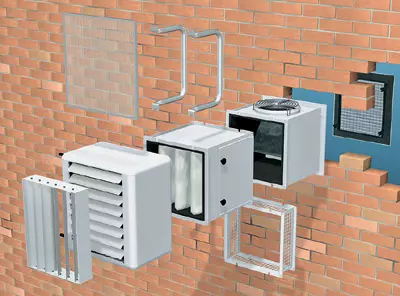
Portable heat guns, in contrast to household fan heaters, are not aesthetic load. Such things are purely practical, the reliability is more important for them, impact resistance. The housing of such devices is made of steel sheet, sometimes from the "stainless steel". Strength is provided by internal ribs of stiffness, as well as a frame that can simultaneously serve both a stand and carrying handle. To supply the flow of warm air to the desired side at the outlet of the gun (both in stationary and in some portable models), the control direction is set to the rotary grille (blinds are moved manually in one or in two planes).
If you need a portable heat gun, which is called, at a time (for example, dry the foundation concrete), worry about the durability of the components that are included in its composition, maybe it is not worth it. It is quite suitable for a domestic model with spiral heaters. With power up to 3-6 kW, its heaters work from the 220V network, although more powerful, as a rule, require a three-phase current with a voltage of 380V. Buying a portable gun for long-term exploitation, it is important to remember that the trouble-free operation of semi-industrial fan heaters, fully or partially commissioned by foreign elements (heaters, electric motors with imperts), often turns out to be longer (sometimes ten times) than the work of domestic technology. It is preferable to acquire the technique of a well-known brand with a German electric motor and German or Italian Tanes. The best models during the operation of the fan block and the beans on the surface of the latter even in the pitch darkness is not noticeable not a single luminous area.
The family of portable thermal cannons is truly huge. From domestic manufacturers of this kind of equipment, you can note the trademarks "Tropik", "Elara", "Makar", "Teplomas", "Noval-Amoror", "Innient", Hintek, "Arktos", "Meteor", "Barhan", "Favorite", "Electric". Foreign manufacturers of portable cannons are the leaders of the FRICO market, Veab, El-Bjorn (Sweden) and Systemair (Norway). The cost of domestic portable equipment fluctuates within $ 15-50 per 1 kW of power, imported devices according to this indicator cost more than $ 30-100. Stationary models are mainly produced abroad, the Systemair, Frico, Veab technique comes to Russia. The devices of this type are associated with the automation system and installation will cost $ 100-300 per 1 kW of the installed power.
| FINNWIK FB3. Manufacturer: Frico. Heating capacity: 2000/3000W Heater: TEN. Power Voltage: 220V Thermostat: Yes Mass: 6kg Cost: $ 199 Power Range for Series: 3-15 kW |
| Tiger P53. Manufacturer: Frico. Heating capacity: 2500/5000W Heater: TEN. Power Voltage: 380V Thermostat: Yes Mass: 6.7 kg Cost: $ 289 Power Range for Series: 2-30 kW |
| TEV-3. Manufacturer: "Arktos" Heating capacity: 1500/3000W Heater: TEN. Power Voltage: 220V Thermostat: Yes Mass: 6kg Cost: $ 148 Power Range for Series: 3-15 kW |
| TV-18T. Manufacturer: "Elara" Heating capacity: 7500/15000W Heater: TEN. Power Voltage: 380V Thermostat: Yes Mass: 29kg. Cost: $ 400 Power Range for Series: 3-21 kW |
| EN 9N. Manufacturer: Veab. Heating capacity: 6000/9000W Heater: TEN. Power Voltage: 220V Thermostat: Yes Mass: 9.7 kg Cost: $ 260 Power Range for Series: 2-15 kW |
| TPC-9 Manufacturer: "TROPIC" Heating capacity: 6000/9000W Heater: TEN. Power Voltage: 380V Thermostat: Yes Mass: 11kg Cost: $ 255 Power Range for Series: 2-22.5 kW |
| Makar TV-15 Manufacturer: "ECONICA-TECHNO" Heating capacity: 9000/15000W Heater: TEN. Power Voltage: 380V Thermostat: Yes Mass: 24kg Cost: $ 375 Power Range for Series: 3-21 kW |
| ETV-3. Manufacturer: "Electric" Heating capacity: 1500/3000W Heater: Spiral Power Voltage: 220V Thermostat: NO Mass: 7kg Cost: $ 137 Power Range for Series: 1.8-24 kW |
| VF 31. Manufacturer: El-Bjorn. Heating capacity: 1650/3300W Heater: TEN. Power Voltage: 220V Thermostat: Yes Mass: 6kg Cost: $ 205 Power Range for Series: 2.2-15 kW |
| KEV-15S. Manufacturer: "Teplomas" Heating Power: Max 15000W Heater: Operated Ten Power Voltage: 380V Thermostat: Yes Mass: 28kg Cost: $ 355 Power Range for Series: 2-18 kW |
| * - all models are equipped with a thermostat |
The editorial office thanks the "supermarket of the perfect climate", "Heatlimat", Vitek, Polaris, "RFK-Climate" for helping the organization of filming, as well as "Teplomas", "Tropic", "Makar", "Arctic" and Systemair for help in preparing material.

